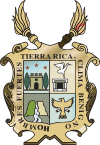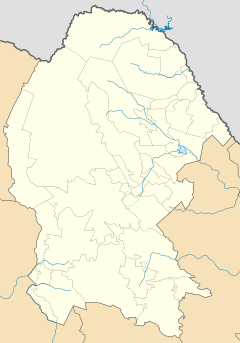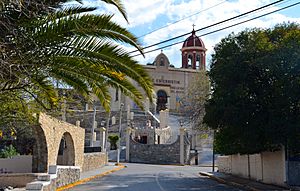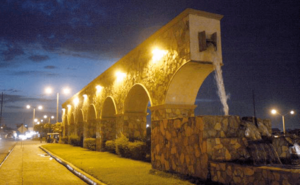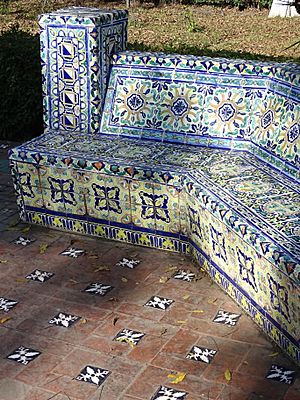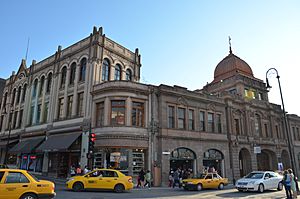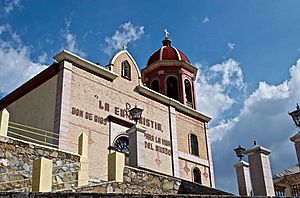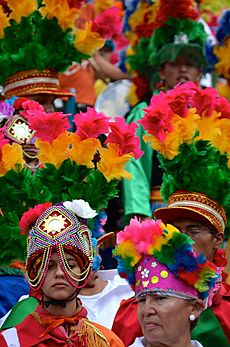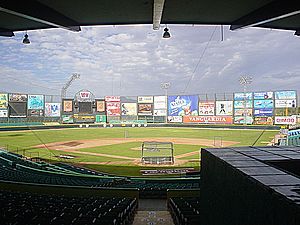Saltillo facts for kids
Quick facts for kids
Saltillo
|
||
|---|---|---|
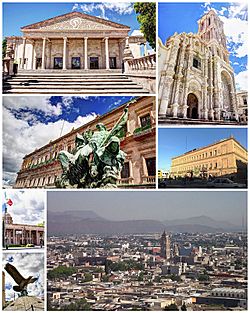
From top to bottom and from left to right: Fernando Soler City Theater, Saltillo Cathedral, Plaza de la Nueva Tlaxcala, Government Palace, Palace of the Congress of the State of Coahuila, Museum of the Birds of Mexico and Panoramic of the city.
|
||
|
||
| Nickname(s):
The Athens of Mexico, The Detroit of Mexico
|
||

Location of Saltillo within the municipality
|
||
| Country | ||
| State | ||
| Founded | July 25, 1577 | |
| Founded as | Villa de Santiago del Saltillo | |
| Founded by | Alberto del Canto | |
| Elevation | 1,600 m (5,250 ft) | |
| Population
(2015)
|
||
| • City | 807,537 | |
| • Metro | 923,636 | |
| • Demonym | Saltillense | |
| GDP (PPP, constant 2015 values) | ||
| • Year | 2023 | |
| • Total | $29.4 billion | |
| • Per capita | $28,400 | |
| Time zone | UTC−6 (CST) | |
| • Summer (DST) | UTC−5 (CDT) | |
| Website | www.saltillo.gob.mx | |
Saltillo is the capital and largest city in the Mexican state of Coahuila. It is also the main city of the Saltillo area. Saltillo is connected to Mexico City and Monterrey by major roads and railways. In 2020, Saltillo had a population of 879,958 people. Its wider metropolitan area had over 1 million people. This makes Saltillo the biggest city in Coahuila and the 14th most populated metropolitan area in Mexico.
Saltillo is a very industrial city. It has one of the largest car industries in Mexico. Many big companies like General Motors and Stellantis have plants here. The city also makes many other products for international companies. Saltillo is known as an important center for trade, communication, and manufacturing.
Contents
- Saltillo's Story: A Look at Its Past
- Saltillo's Natural Surroundings
- People of Saltillo: Demographics
- Saltillo's Economy: What It Makes
- Learning in Saltillo: Education
- Exploring Saltillo: Places to See
- Saltillo's Unique Culture
- Sports in Saltillo
- Getting Around Saltillo: Transportation
- Saltillo's Sister Cities
- Famous People from Saltillo
- See also
Saltillo's Story: A Look at Its Past
Early Days: The Colonial Era
Saltillo was founded in 1577 by a Spanish explorer named Alberto del Canto. It was called Villa de Santiago del Saltillo. This makes it one of the oldest Spanish settlements in Northern Mexico. The city's name comes from a small waterfall (saltillo means "little jump" or "waterfall") from a spring. This spring is still visited today at the Parish of the Holy Christ of the Ojo de Agua.
In 1591, the Spanish brought their allies, the Tlaxcaltec people, to live in a separate town nearby. This town was called San Esteban de Nueva Tlaxcala. It helped the Spanish efforts to settle the land. Saltillo grew slowly at first because of conflicts with local tribes and not enough water. One hundred years after it was founded, Saltillo had only about 300 people. The nearby Tlaxcaltec town, San Esteban, had about 1,750 people.
In the 1700s, Saltillo became an important trading center. It connected central Mexico to areas like Texas. It also sent wheat to the silver mines in Zacatecas. Saltillo grew into a place with good trade and farming. It also became important for government at the end of the 1700s.
Merchants, mostly from Spain, were very important to Saltillo's economy. They sold many different goods in their shops. These merchants often married into local families and bought land.
Later in the 1600s, Saltillo started an annual trade fair. This fair sold Mexican goods and animals to places as far away as China and Europe. Saltillo could grow wheat when there was enough water. But droughts were always a problem. In the 1700s, Saltillo also supplied animals for work.
Becoming Part of Mexico
In 1824, Saltillo became the capital of the state of Coahuila y Tejas. This state included Coahuila and most of what is now Texas. For a short time, the city's name was changed to Leona Vicario. This was to honor a female hero of the Mexican War of Independence. But in 1831, the name was changed back to Saltillo.
Saltillo was the capital of this large territory for almost ten years. Then, Texas became independent in 1836 after the Texas Revolution. Mexico and Texas still had disagreements about their border. There were also conflicts with Native American tribes and other groups. In 1840, a battle took place in Saltillo. Texan and Tejano fighters attacked the city's government. They wanted to create a new country called the Republic of the Rio Grande.
In 1845, the United States took over Texas. This led to the Mexican–American War. In 1846, American General Zachary Taylor occupied Saltillo. He wanted to protect his army in Monterrey. In 1847, a big battle happened near Saltillo, called the Battle of Buena Vista. The Mexican army had to move south after this battle.
Modern Times: From Revolution to Industry
Modern changes came to Coahuila when the railroad arrived in 1880. By 1890, Saltillo had telegraphs, telephones, and streetlights. New cultural buildings like theaters and plazas were also built. Hospitals and water systems improved the city.
During the Mexican Revolution (1910-1920), different groups took over Saltillo. Many people were forced to join these groups. Because of this, many families left the city and moved to Texas.
In the 1900s, Saltillo began to change from farming to industry. In 1923, the Antonio Narro Agrarian University was founded. Later, in the 1940s and 1950s, more important universities were built. These included the Monterrey Institute of Technology and Higher Education and the Autonomous University of Coahuila.
The biggest industrial growth happened in the 1970s and 1980s. Car companies like General Motors and Chrysler came to Saltillo. Many other companies that supply parts to car makers also moved here. Because of this, Saltillo and its nearby areas became known as the "Detroit of Mexico". Now, the city is trying to bring in other types of industries too. These include medicine, home appliances, and even parts for airplanes.
Saltillo's Natural Surroundings
Saltillo is overlooked by El Cerro del Pueblo (The Town Hill) and its large cross. Because of its high elevation, Saltillo is cooler and windier than nearby Monterrey. The city is located in the Chihuahuan Desert, close to Arteaga. The Zapalinamé mountains surround Saltillo. These mountains are part of the Sierra Madre Oriental. A local story says that if you look at the mountains, you can see the face of Zapalinamé. He was a tribal leader who fought against the Spanish in 1584.
Mountains and Rivers
San Lorenzo Canyon
The San Lorenzo Canyon is southeast of Saltillo in the Sierra de Zapalinamé. It has very old rock formations from the Jurassic period. This canyon is a popular place for outdoor activities. People enjoy rock climbing, rappelling, mountain biking, hiking, and camping here.
Waterways of Saltillo
Saltillo has several streams, or arroyos, that flow through or near the city:
- Arroyo de los Ojitos: This stream starts south of Francisco Coss Boulevard and flows towards Benito Juárez Street.
- Arroyo de la Tortola: It begins in the Magisterio neighborhood and passes through the city center. It flows near the Coahuila school and then underground.
- Arroyo del Charquillo: This stream starts at Ateneo street. It goes behind the San Isidro sports complex and through the lake of the Sports City. It then continues towards the Tecnológico de Monterrey.
- Cevallos Creek: This creek starts in the Zapaliname mountain range. It flows past the Lomas de Lourdes neighborhood and the Mercado de Abastos.
- Arroyo de la Navarreña: It begins in the mountains near Vista Hermosa. It flows through neighborhoods like Founders and Morelos, and past the Dolores Pantheon.
Land El Aguaje
This area is in the San Lorenzo Canyon. Its rock formations help water soak into the ground. This refills the underground water sources that supply Saltillo with drinking water. In 2008, the government bought this land to protect it.
Tallest Mountains
- Sierra La Concordia: This is the highest mountain in the area. It reaches 3,462 meters (11,358 feet) above sea level.
- Sierra Catana: This mountain is 3,104 meters (10,184 feet) above sea level.
Saltillo's Weather
Saltillo has a semi-arid climate. This means it's quite dry. Even though it's in the Chihuahuan Desert, Saltillo is cooler than other desert cities. This is because it is high up, at 1,600 meters (5,250 feet) above sea level. Summers are a bit hot with cool nights. Winters are sunny but cool. It doesn't rain much, but most rain falls in the summer. Snow and freezing temperatures can happen, but not every year.
| Climate data for Saltillo (1951–2010, extremes 1949–2018) | |||||||||||||
|---|---|---|---|---|---|---|---|---|---|---|---|---|---|
| Month | Jan | Feb | Mar | Apr | May | Jun | Jul | Aug | Sep | Oct | Nov | Dec | Year |
| Record high °C (°F) | 36.5 (97.7) |
33.0 (91.4) |
36.5 (97.7) |
39.0 (102.2) |
41.0 (105.8) |
40.5 (104.9) |
39.5 (103.1) |
37.0 (98.6) |
38.5 (101.3) |
39.0 (102.2) |
34.5 (94.1) |
32.6 (90.7) |
41.0 (105.8) |
| Mean daily maximum °C (°F) | 19.7 (67.5) |
21.4 (70.5) |
24.7 (76.5) |
27.9 (82.2) |
29.9 (85.8) |
30.3 (86.5) |
29.7 (85.5) |
29.2 (84.6) |
26.6 (79.9) |
24.9 (76.8) |
22.6 (72.7) |
20.1 (68.2) |
25.6 (78.1) |
| Daily mean °C (°F) | 12.1 (53.8) |
13.6 (56.5) |
16.7 (62.1) |
20.0 (68.0) |
22.3 (72.1) |
23.2 (73.8) |
23.0 (73.4) |
22.6 (72.7) |
20.3 (68.5) |
18.0 (64.4) |
15.2 (59.4) |
12.8 (55.0) |
18.3 (64.9) |
| Mean daily minimum °C (°F) | 4.5 (40.1) |
5.7 (42.3) |
8.7 (47.7) |
12.1 (53.8) |
14.8 (58.6) |
16.1 (61.0) |
16.2 (61.2) |
15.9 (60.6) |
14.0 (57.2) |
11.2 (52.2) |
7.8 (46.0) |
5.5 (41.9) |
11.0 (51.8) |
| Record low °C (°F) | −14.5 (5.9) |
−13.0 (8.6) |
−6.0 (21.2) |
0.0 (32.0) |
5.0 (41.0) |
6.5 (43.7) |
7.0 (44.6) |
2.0 (35.6) |
1.3 (34.3) |
−3.0 (26.6) |
−5.0 (23.0) |
−11.0 (12.2) |
−14.5 (5.9) |
| Average precipitation mm (inches) | 15.1 (0.59) |
12.2 (0.48) |
8.3 (0.33) |
16.9 (0.67) |
30.6 (1.20) |
46.4 (1.83) |
61.4 (2.42) |
54.5 (2.15) |
64.1 (2.52) |
30.1 (1.19) |
11.7 (0.46) |
13.1 (0.52) |
364.4 (14.35) |
| Average precipitation days (≥ 0.1 mm) | 3.4 | 2.7 | 2.1 | 3.4 | 5.2 | 6.4 | 8.8 | 9.0 | 8.2 | 5.1 | 2.9 | 3.2 | 60.4 |
| Average snowy days | 0.1 | 0.0 | 0.0 | 0.0 | 0.0 | 0.0 | 0.0 | 0.0 | 0.0 | 0.0 | 0.0 | 0.2 | 0.3 |
| Average relative humidity (%) | 58.7 | 55.2 | 52.3 | 51.6 | 54.9 | 60.2 | 65.4 | 68.4 | 75.6 | 68.5 | 60.2 | 57.1 | 60.7 |
| Source 1: Servicio Meteorologico Nacional, NOAA (relative humidity and sun 1981–2010) | |||||||||||||
| Source 2: Colegio de Postgraduados (snow days) | |||||||||||||
People of Saltillo: Demographics
How Many People Live Here?
In 2020, Saltillo was the 14th most populated city in Mexico. It had 864,431 people living there.
| Historical population | ||
|---|---|---|
| Year | Pop. | ±% |
| 1900 | 23,996 | — |
| 1910 | 35,414 | +47.6% |
| 1921 | 40,451 | +14.2% |
| 1930 | 45,272 | +11.9% |
| 1940 | 49,430 | +9.2% |
| 1950 | 69,842 | +41.3% |
| 1960 | 98,839 | +41.5% |
| 1970 | 161,114 | +63.0% |
| 1980 | 284,937 | +76.9% |
| 1990 | 420,947 | +47.7% |
| 2000 | 562,587 | +33.6% |
| 2010 | 709,671 | +26.1% |
| 2020 | 864,431 | +21.8% |
| Source: www.inegi.org.mx | ||
| Vertical bar chart demographic of Saltillo between 1900 and 2020 |
|
EasyTimeline 1.90
|
| Population from the censuses of the National Institute of Statistics and Geography (INEGI) from 1900 to 2020. |
Saltillo's Economy: What It Makes
Saltillo is famous for its unique products. These include Saltillo tile and colorful sarapes, which are traditional woven blankets.
The city is a major center for making cars and trucks. Companies like Mercedes-Benz, General Motors, and Chrysler have large factories here. In fact, a big part of all cars and trucks made in Mexico are put together in Saltillo.
Saltillo is also home to Grupo Industrial Saltillo. This is a large company that makes many different things. They produce home appliances, silverware, and car parts. The General Motors plant in Saltillo makes vehicles for export to other countries like Japan and Canada. It also makes cars for people in Mexico.
Learning in Saltillo: Education
Saltillo has several important universities and colleges. These include the Universidad Autónoma de Coahuila, the Instituto Tecnológico de Saltillo, and the Tec de Monterrey Saltillo Campus. Other notable schools are El Instituto de Filologia Hispanica, Universidad Carolina, and the Universidad Autónoma Agraria Antonio Narro.
Exploring Saltillo: Places to See
Saltillo has many interesting places to visit, from cultural centers to historic churches and museums.
Cultural Spots
- Fernando Soler City Theater: This theater opened in 1979. It hosts many events like plays, operas, concerts, and festivals.
- Paraninfo del Ateneo Fuente: This auditorium is at the Universidad Autonoma de Coahuila. It has beautiful murals by Salvador Tarazona. One mural shows science, and the other shows arts and culture.
- Casa Purcell Cultural Center: This old house was built in the 1800s. It is now a cultural center with art exhibitions.
- García Carrillo Theater Cultural Center: This center has a gallery for art shows. It also has an auditorium for talks, concerts, and movies.
- The Cultural Center Vito Alessio Robles: This building used to be the City Council. It has a mural about Coahuila's history and a library with old books.
- Coahuilense Institute of Culture: This place promotes art and culture from the state. It has an art gallery, workshops, and a bookstore.
- El Recinto a Juárez: This building houses a historical research college. It offers library services and hosts plays and talks.
- University Cultural Heritage Site: This old house from 1680 now shows the city's art collection.
- Aurora Morales de López University Cultural Site: This is a place for art from the Autonomous University of Coahuila.
Religious Buildings
- Cathedral of Santiago Apostol: This church started being built in 1745. It became a Cathedral in 1891. It mixes different old building styles. Inside, you can see beautiful altarpieces and 45 oil paintings.
- Church of Santo Cristo del Ojo de Agua: This church is on top of the hill where the city's spring is. It holds a special statue of Christ. Many people believe this statue is why the spring exists.
- Parish of San Esteban: This temple was built in 1592. It was for the Tlaxcaltec people who lived in the town of San Esteban.
- Temple of San Juan Nepomuceno: This church was built in the 1800s. It has oil paintings and sculptures inside.
- Sanctuary of Guadalupe: This church was built in 1890 in a Gothic style. It has pointed windows and arches, typical of Gothic architecture.
Museums to Explore
Saltillo has about 22 museums. Here are some of them:
- Museum of the Coahuilenses Presidents: This museum honors the five presidents of Mexico who came from Coahuila. It shows photos, documents, and personal items from these leaders.
- Landín Chapel Museum: This old chapel from the 1700s has been restored. It now has a museum area with 20 religious paintings from the 17th and 18th centuries.
- Museo de la Angostura: This museum remembers the Mexican victory against the United States in 1847. It is in an old house that used to be a school.
- Catrina Museum: This colorful museum tells the story of Catrina. She represents death in the traditional Day of the Dead celebration.
- Bird Museum of Mexico: This museum has over 2,500 birds. It is the largest bird collection in Mexico and Latin America. Most of the birds are from Mexico.
- Museo del Normalismo: This museum tells the story of education in Coahuila. It has old teaching tools and a room for famous graduates.
- Museo del Sarape and Typical Costumes: This museum shows the history of the sarape. It has some of the first sarapes made in the 1800s and 1900s. It also shows traditional clothes from the region.
- The Gyroscope Museum: This is a science museum.
- Rubén Herrera Museum: This house from the 1700s displays art by Rubén Herrera. He was a master artist from Zacatecas.
- MAG Graphic Arts Museum: This museum has over 1,400 items that belonged to José Guadalupe Posada. He was a famous Mexican engraver known for his social cartoons.
- Cato Museum: This museum is about the city's journalist and historian.
- Museo del Horror: This museum is dedicated to horror.
Saltillo's Unique Culture
Saltillo's local culture is similar to other parts of Northern Mexico. But it also has its own special traditions and history.
Matachines Dance
The danza de matachines is a lively dance performed in Saltillo and other parts of Mexico. It's a festive dance with a long history. Some say it came to America with the Spanish. It is similar to dances from Spain, Portugal, Italy, and France. In Mexico, the dance changed and became linked to indigenous cultures. The event is called matlachinada, and the dancers are called matlachines.
In Saltillo, the dance honors the Holy Christ. The dancers wear colorful costumes with feathers, bows, and arrows. They also wear decorated skirts and sandals. The dance is organized by people from the Ojo de Agua neighborhood. This area was once home to Tlaxcaltec people.
The Saltillo Sarape
The sarape (also called serape or jorongo) is a rectangular blanket. It is usually worn by men. It has bright, multicolored stripes, like a rainbow. The sarape is one of Mexico's most famous items. It is often made of wool to keep warm, but also from cotton. The way it's made, including the yarn and knots, affects its weight and feel. The sarape is traditional in many parts of Mexico, especially Saltillo. Tlaxcalan settlers brought the sarape to Coahuila.
Sarapes can be used as coats, blankets, bedspreads, or even wall decorations. They are also placed on horses before the saddle.
Pulque Bread
Pulque bread is a very old tradition in Saltillo. It is a sweet bread made with wheat flour, water or milk, egg, and sometimes lard. What makes it special is the use of pulque. Pulque is a fermented drink made from the agave plant. This gives the bread a unique flavor, sweetness, and moist texture. Many different types of pastries are made with this dough. These include pecan empanadas, chorreadas, and muffins. While Saltillo is known for this bread, it's also found in other Mexican states like Hidalgo and Puebla.
The Saltillo Rondalla
Saltillo is famous for its rondalla, a type of musical group. The 'Rondalla de Saltillo' has been a top group in Mexico for over 40 years. They have their own unique style and have made many recordings. They use guitars, requintos (smaller guitars), double bass, and singers. The group has toured many countries and recorded 30 albums.
Sports in Saltillo
Saltillo has a long history with baseball. The sport started here in the late 1800s. The city's professional team, the Saraperos de Saltillo, joined the Mexican Baseball League in 1970. They have won three championships (in 1980, 2009, and 2010). They have also won eight division titles.
Other professional sports teams in Saltillo include:
| Club | Sport | Founded | League | Venue |
|---|---|---|---|---|
| Dinos Saltillo | American football | 2016 | LFA | Estadio Olímpico Francisco I. Madero |
| Saltillo F.C. | Soccer | 2019 | Serie A de México | Estadio Olímpico Francisco I. Madero |
| Saltillo Soccer F.C. | Soccer | 1995 | Liga TDP | Estadio Olímpico Francisco I. Madero |
Getting Around Saltillo: Transportation
Air travel for the Saltillo area uses Plan de Guadalupe International Airport. It's only about 15 minutes from downtown Saltillo. The airport handles many cargo flights each day, but it does not have passenger flights. Saltillo also has a good bus system and many taxis for getting around.
Saltillo's Sister Cities
Saltillo has special connections with other cities around the world. These are called sister cities:
 Austin, USA
Austin, USA Canton, USA
Canton, USA Guatemala City, Guatemala
Guatemala City, Guatemala Lansing, USA
Lansing, USA Holguín, Cuba
Holguín, Cuba Tlaxcala City, Mexico
Tlaxcala City, Mexico Windsor, Canada
Windsor, Canada
Famous People from Saltillo
In the 1900s, Saltillo was called "the Athens of Mexico." This was because many smart and famous people came from here.
- Manuel Acuña: A writer from the 1800s, known for his poetry.
- Rubén Aguirre: An actor famous for playing Professor Jirafales in the TV show El Chavo del Ocho.
- Vito Alessio Robles: A military officer, writer, and journalist who was part of the Mexican Revolution.
- Pedro Arce: A professional football (soccer) player.
- Ernesto Boardman: A competitive archer who won a gold medal in 2015.
- Humberto Elizondo: A film and television actor.
- Louis Febre: A composer, known for his work on the TV series Smallville.
- Roque González Garza: A Mexican general who was acting president in 1915.
- Magda Guzmán: A famous actress.
- Rosario Ibarra: An activist and important figure in Mexican politics.
- Brissia Mayagoitiae: A singer.
- José Narro Robles: A former director of the National Autonomous University of Mexico's medical school.
- Andrés Soler: An actor from the Golden Age of Mexican cinema.
- Fernando Soler: A film actor, director, and writer.
- Julio Torri: A writer and teacher.
- Karla Wheelock: A mountaineer, writer, and speaker. She was the first woman from Latin America to climb the Seven Summits (the highest mountains on each continent).
See also
 In Spanish: Saltillo para niños
In Spanish: Saltillo para niños


